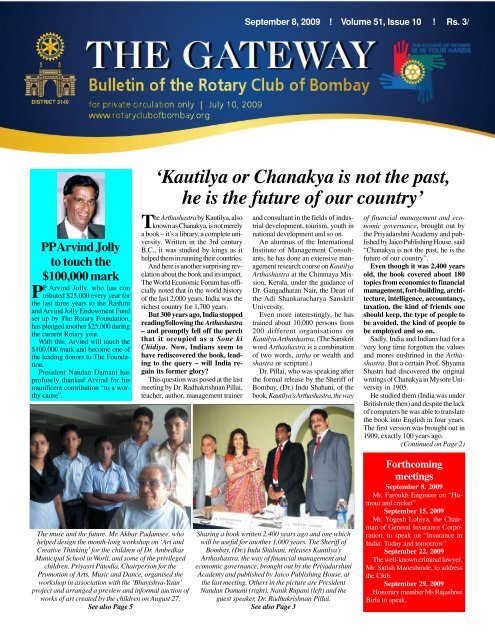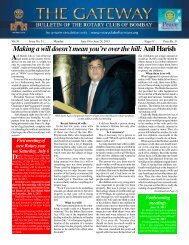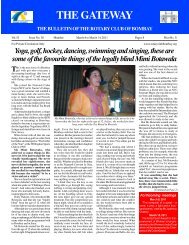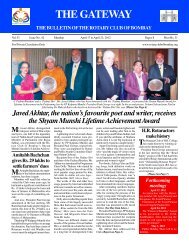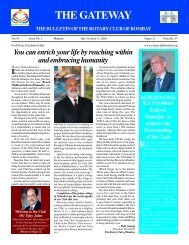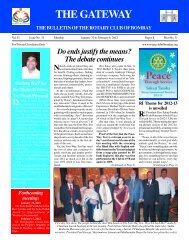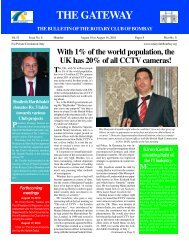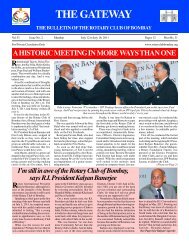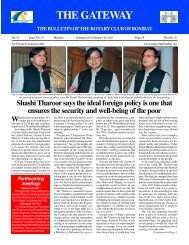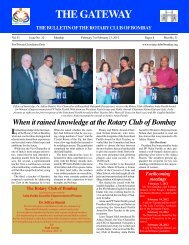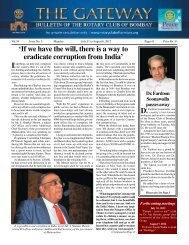Gateway 080909 for Viraf.pmd - Rotary Club of Bombay
Gateway 080909 for Viraf.pmd - Rotary Club of Bombay
Gateway 080909 for Viraf.pmd - Rotary Club of Bombay
- No tags were found...
You also want an ePaper? Increase the reach of your titles
YUMPU automatically turns print PDFs into web optimized ePapers that Google loves.
And did Chanakya have anything to say about the presentglobal economic crisis?(Continued from Page 1)Recently, Pr<strong>of</strong>. Shastri’s grandsonwas quoted by the media as sayingthat nobody was celebrating the 100thanniversary <strong>of</strong> the publishing <strong>of</strong>Arthashastra.The new book was pro<strong>of</strong> that theanniversary had not gone unnoticed,said Dr. Pillai, who was confident thatKautilya’s Arthashastra would be relevant<strong>for</strong> another 1,000 years.“This book is the past, present andfuture <strong>of</strong> India. Talking about it is liketalking about a library, about an institution….Books like this have an impact<strong>for</strong> thousands <strong>of</strong> generations.“Kautilya’s Arthashastra is not thefirst arthashastra. There were manyothers be<strong>for</strong>e it and many others afterChanakya. When I asked my guru Dr.Gangadharan Nair how come onlyKautilya’s Arthashastra had survivedso many generations, he said it wasbecause <strong>of</strong> one attribute, viz., quality.“That quality had come about dueto thorough research. Chanakya hadstudied all the arthashastras, understoodthe principles and also <strong>for</strong>eseenthe problems that would arise thousands<strong>of</strong> years later and written thisone book which created history.”Dr. Pillai said Chanakya had describedthe four stages <strong>of</strong> wealth.One, wealth identification. Wherewould money come from? This requiredresearch to identify sources <strong>of</strong>wealth and opportunities to accumulateit. Merely learning about thesewould not make one rich.There<strong>for</strong>e, the second stage waswealth creation. This would only followas a consequence <strong>of</strong> hard work.Page 2, THE GATEWAY, 8th September, 2009But after one became rich or managedto acquire wealth, there came anotherchallenge, that <strong>of</strong> managing wealth.And so the third stage was wealthmanagement through investments,securities and so on in order to havesufficient wealth <strong>for</strong> oneself, one’s familyand a few generations.But Chanakya was a visionary whotalked about the next, the fourth stage<strong>of</strong> wealth, that is, wealth distribution.“He starts with you and tells youto make yourself secure first. And inhow many verses? In 6,000 sutras onwealth management! No other bookin the world has ever covered suchdetails <strong>of</strong> accounting, auditing, taxationand so on.”Did Chanakya have anything to sayabout the present global economic crisis?Yes, Dr. Pillai insisted, Chanakyawas one step ahead.While most economists and otherexperts were per<strong>for</strong>ming a postmortem<strong>of</strong> the current situation,Chanakya had talked about preventionbeing better than cure.He stated clearly that if regularchecks and balances, or auditing, wereconducted from time to time, then economiccrises would not occur. Further,it was the duty <strong>of</strong> the ruler to ensurethat accounting and checks and balancesauditing took place from time totime.Dr. Pillai quoted what he called “onevery strong sutra” from among the6,000. It was simple but powerful:Praja sukhe sukham raja, prajachahite hitam.It meant that at the end <strong>of</strong> it all, it(money) had to make society happy.Indu reveals some interesting factsWhen Mr. Deepak Parekh, theChairman <strong>of</strong> HDFC, addressedstudents <strong>of</strong> H.R. College <strong>of</strong>Commerce and Economics in 1991,he left a deep impression on them.Today, 18 years later, three FirstYear students, who were sitting inthe first row then, are Vice-Presidentswith HDFC.City Sheriff and College PrincipalIndu Shahani shared this nuggetat the last meeting after releasingthe book, Kautilya’s Arthashastrabrought out by the PriyadarshniAcademy.But this was not the only one;she related another that was evenmore inspiring.While compiling the history <strong>of</strong>the College which is about to complete50 years, it was noted thatthe founder Principal had said inChanakya was the first thinker in Indian history who did not write <strong>of</strong>f ordisparage money, asserts Dr. Radhakrishnan PillaiTrue, money was a resource, but “finally,it should lead to happiness”.In other words, Chanakya wasthe first thinker in Indian historywho did not write <strong>of</strong>f or disparagemoney.“There is no condemnation, callingthe rich filthy rich. He says onlymoney can give happiness, but thatdoesn’t mean that money is the end <strong>of</strong>everything. He also talks about wealthdistribution.“When J.R.D. Tata was askedwhether he wanted India to be a superpower,he had replied: ‘I want Indiato be a happy country’. And happiness,Chanakya says, can only comeabout if we have the financial resources.He is practical; Chanakya’s greatestsuccess is that he is very practical.”Dr. Pillai said that during a recentvisit to Delhi he noticed that in theSupreme Court Museum, where pride<strong>of</strong> place was given to the Preamble <strong>of</strong>the Constitution, “We, the People <strong>of</strong>1960 that “this is a commerce collegeand not a commercial college;we want the ideals <strong>of</strong> great leadersto be emulated”.He then held up the first book(on J.N. Tata) that was presentedto the College. He said that “Tata’sideals are what we would like t<strong>of</strong>ollow in the college”.And it so happened that out <strong>of</strong>the first batch <strong>of</strong> 125 students fromH.R. College, 42 had joined theTata’s and worked with them <strong>for</strong>40 years.Turning to the Teach <strong>for</strong> Indiaprogramme and its founder CEOMs Shaheen Mistri, Indu said thather talk coincided with Teacher’sDay (September 4) which was thebirthday <strong>of</strong> Dr. S. Radhakrishnan.It was he (Dr. Radhakrishnan)who had said at the dawn <strong>of</strong> Independencethat “India’s future willbe shaped in her classrooms”.India…” the lines next to it stated unambiguouslythat “We derive our Constitutionfrom Kautilya’s Arthashastra”.He urged his audience to read thebook, talk about it and gift it to friends,colleagues and associates, insisting thatit was a book whose time had come.He recalled the quotation <strong>of</strong> VictorHugo which was used by the presentPrime Minister, Dr. Manmohan Singh,when he was the Finance Minister in1991 to usher in the era <strong>of</strong> liberalisationand globalisation:“Armies can be resisted, but not anidea whose time has come.”Dr. Pillai added: “Chanakya’sand Kautilya’s Arthashastra’s timehas come. Now it’s your choicewhether you want to be a part <strong>of</strong>this history, or you wish to justwatch as this history is being created.”The vote <strong>of</strong> thanks was proposedby Pradeep Saxena.While this was indeed happening,increasingly, it was the youth <strong>of</strong> Indiawho were shaping its future.Teach <strong>for</strong> India was a great movementwhich many people haddreamt about but which Ms Mistrihad put into action. Young peoplewere leaving lucrative jobs with greatcompanies and going to local, municipaland general schools to teach.And teaching was giving themmore maturity and experience thanthe corporate world could give themin a hundred years.“I compliment Shaheen and herteam. The message we should takehome is to spend one hour a monthwith the educational institution thatwe attended and give back to society.Nobody wants your money oryour resources. We want your timeand your experience; share it withthe young students,” Indu added.See also Page 4
THE ‘ARTHASHASTRA’ IS 2,400 YEARS OLD YETIT ANSWERS ALL QUESTIONS UNDER THE SUNAfascinating new book, Kautilya’sArthashastra, the way <strong>of</strong> financialmanagement and economic governance,brought out by NanikRupani and the Priyadarshini Academyand published by M/s JaicoPublishing House, was released at thelast meeting by the Sheriff <strong>of</strong> <strong>Bombay</strong>,(Dr.) Indu Shahani.Put together by a team <strong>of</strong> economistsworking under Kiran Nanda atthe Indian Merchants’ Chamber, thebook is a compilation <strong>of</strong> contemporaryarticles on Kautilya’s originaltreatise in Sanskrit.Indu, who is also the Principal <strong>of</strong>H.R. College <strong>of</strong> Economics and a distinguishededucationist, after unveilingthe book recalled an interestingexperience during a visit to the LondonBusiness School in mid-August.At a high level colloquium on financeand the ills <strong>of</strong> the global economicscenario, the main speaker saidthat “what’s really gone wrong is that‘Green Earth Summit’ to be heldon September 13The national seminar on globalwarming and water management,styled “Green Earth Summit”, willbe held on Sunday, September 13, atHotel Leela. The <strong>Rotary</strong> <strong>Club</strong> <strong>of</strong><strong>Bombay</strong> is the Platinum <strong>Club</strong> Host<strong>for</strong> the event.Another important programme willbe held at the same venue, on the sameevening. This will be The <strong>Rotary</strong>Foundation (TRF) Seminar at whichPast R.I. President Bill Boyd will bethe chief guest.Among the speakers at the “GreenEarth Summit” will be Dr. RajendraSingh, a recipient <strong>of</strong> the MagsaysayAward, who will be presented with aLifetime Achievement Award by District3140.PRIP Bill Boyd, who was instrumentalin <strong>for</strong>ging a joint partnershipbetween <strong>Rotary</strong> and UNAIDS <strong>for</strong>water projects, will address the closingplenary session.Other speakers will be Past R.I.Director Ron Denham, Chairman <strong>of</strong>the Water and Sanitation RotarianAction Group (WASRAG) fromCanada; Dr. Ajit Gokhale, water conservationist;Ms Suprabha Marathe<strong>of</strong> the <strong>Bombay</strong> Municipal Corporation;Pr<strong>of</strong>. O.P. Kulkarni, an experton solar energy; Mr. Shri Bhagwan,the Chief Conservator <strong>of</strong> Forests; andMr. Prabhat Singh, author and environmentalist.we have not linked corporate financeor finance and accounting to othersubjects… and the most importantis economics”.But it was no surprise to find inthe book, Kautilya’s Arthashastra,that even in 4th century B.C.,Kautilya had said that there could beno accounting without a link to economics.She added that India was probablyone <strong>of</strong> the only countries insulatedfrom the worldwide financial crisis –because “we have always understoodArthashastra better than the world”.Programme Chairman NanikRupani, who is also the Chairman <strong>of</strong>the Priyadarshini Academy, thankedIndu <strong>for</strong> coming from Delhi <strong>for</strong> thebook launch. He also thanked KiranNanda <strong>for</strong> her assistance in puttingthe book together and Mr. AshwinMehta, Mr. Akash Mehta and Mr.Sharma <strong>of</strong> Jaico Publishing House <strong>for</strong>their co-operation.There are limited seats andRotarians have been requested to registeras early as possible. The registrationcharges are Rs. 1,700. Chequesshould be drawn in favour <strong>of</strong> “<strong>Rotary</strong>Green Earth Summit” and sentto District Treasurer RajendraKinariwala at A-1 Bonanza IndustrialEstate, Ashok Chakravarthy Road,Kandivli (East), <strong>Bombay</strong> 400101.Dr. Bharat Pandya and KumarKewalramani are the Conveners <strong>for</strong>the summit.Nanik recalled that the germ <strong>of</strong> thebook was born in the course <strong>of</strong> a discussionwith (Dr.) Ram Tarneja, wellknownmanagement expert.Kautilya had answers to almost allquestions under the sun, whether financialmanagement, intelligence, thekind <strong>of</strong> friends one should keep, thetype <strong>of</strong> people to be avoided, the kind<strong>of</strong> people to be employed and so on.Asked about the rate <strong>of</strong> taxation,Kautilya had said that taxationworked best when it acted like a honeybeegently taking a little bit <strong>of</strong> thenectar in a flower without disturbingthe flower.He had also suggested that administrativeexpenses were best keptwithin 25% <strong>of</strong> the revenue collection.In other words, his book was a sort<strong>of</strong> readyreckoner <strong>for</strong> making any kind<strong>of</strong> strategic decision.He’s one happy donor. Hon. Joint Secretary Nirav Shah recently donated atelevision set <strong>for</strong> use by the ‘Bhavishya-Yaan’ project at the Dr. AmbedkarMunicipal School in Worli. Others in this picture are (from right) Vice-President Paul George, President Nandan Damani, Chairman AlokSekhsaria and PP Arun SanghiOn the front row. A section <strong>of</strong> the audience at the last meeting. Among thosewho can be spotted are (from left) Tarjani Vakil, PP Kalpana Munshi, (Dr.)Ram Tarneja, the legendary Dr. L.H. Hiranandani and Natoobhai BrahmbhattAnother book, Machiavelli andKautilya, was being put together andwould be published soon, Nanikadded.Donations acknowledgedPresident Nandan thanked Honorary member Mr. Ajay Piramalat the beginning <strong>of</strong> the last meeting<strong>for</strong> his munificent donation <strong>of</strong> Rs. 10lakhs <strong>for</strong> the Community Serviceprojects <strong>of</strong> the <strong>Club</strong> (as reported inThe <strong>Gateway</strong> dated September 1).Next, he thanked the Katgara family<strong>for</strong> the donation <strong>of</strong> Rs. 50,000from the Katgara Foundation <strong>for</strong> theWater Management projects.Nandan also announced the receipt<strong>of</strong> birthday donations from severalmembers during the week gone by.He said that Poonam Kumar haddonated Rs. 11,000; Mudit Jain Rs.2,501; Vijay Meghani Rs. 1,501; and<strong>Rotary</strong>ann Naju Colah Rs. 1,001. Hethanked all <strong>of</strong> them <strong>for</strong> their contributions.At the last meeting(Held on September 1, 2009)PRESIDENT Nandan called themeeting to order and welcomed theguest speakers, visiting Rotarians,<strong>Rotary</strong>anns, guests and others.BIRTHDAYSMembers and <strong>Rotary</strong>anns celebratingtheir birthday during theweek were felicitated.ATTENDANCEMembers 139Visiting Rotarians 4Spouses/<strong>Rotary</strong>anns 9Guests 53Total 205Svc. box collection Rs. 7,1208th September, 2009, THE GATEWAY, Page 3
Teach <strong>for</strong> India hopes to change India by ending inequitiesMs Shaheen Mistry, the founderCEO <strong>of</strong> the Teach <strong>for</strong> Indiaorganisation, made an interesting presentationat the last meeting whenshe briefly explained the concept behindher “movement” and dwelt atlength on its aim <strong>of</strong> creating leaderswho would help end social inequitiesand thus change the country.She said that Teach <strong>for</strong> India was anationwide movement <strong>of</strong> outstandinggraduates and young pr<strong>of</strong>essionalswho took up teaching in underresourcedschools <strong>for</strong> two years andwent on to become leaders and lifelongadvocates <strong>for</strong> equity in education.Once chosen, the youth weretrained in innovative teaching methodsand designated “Fellows”. Afterthey were “placed”, their per<strong>for</strong>mancewas monitored and the impactthey were making measured.Ms Mistri started her talk ratherrhetorically, by asking the audiencesome questions which, she said, sheposed at college campuses.“Are you ready <strong>for</strong> a challenge?”“Do you believe that India needs adifferent kind <strong>of</strong> leader and not oneleader or ten, but thousands <strong>of</strong> leaderswho can change every single issuethat the country is grappling with?”“Do you believe that we have theability to create those leaders?” “Doyou believe that the disparity in thiscountry is unsustainable and that itaffects every single one <strong>of</strong> us hereand that we have the capacity tochange that?”The Teach <strong>for</strong> India movementbelieved that the world was the wayit was not because <strong>of</strong> magic or fluke,but because <strong>of</strong> the ef<strong>for</strong>ts <strong>of</strong> severalgenerations <strong>of</strong> people who had madea difference. However, the presentglobal scenario was depressing, withinnumerable problems in every aspect<strong>of</strong> life.At the same time, there was hopein the fact that “if we really are responsible<strong>for</strong> what we are, then wealso have the ability to shape our future;there<strong>for</strong>e, the actions that wetake now and in the future are goingto shape the world”.Ms Mistri said the Teach <strong>for</strong> Indiamovement believed that the future <strong>of</strong>India would be shaped in her classrooms– and that this would be doneby the youth <strong>of</strong> today, by the best,the brightest and the most committedamong them.In a manner <strong>of</strong> speaking, the futurewould be shaped by these youthwho would take the lead and thusgive the lead. Although they had theopportunity to do what they wanted,they were prepared to give up theirjobs and work full-time <strong>for</strong> 16 hoursa day <strong>for</strong> two years, teaching underprivilegedchildren in under-resourcedclassrooms.Ms Mistry, who has been workingactively on Teach <strong>for</strong> India since2007, is also the founder <strong>of</strong> AkanshaFoundation, a non-pr<strong>of</strong>it organisationwhich works in the field <strong>of</strong> education<strong>for</strong> less-privileged children. Akanshahas grown from 15 children in onecentre to 3,500 across <strong>Bombay</strong> andPune in 19 years.She proceeded to recite a poemthat she had composed to describethe Teach <strong>for</strong> India programme. Theverse ended with the line, It startswith me. And this was the messagethat was conveyed to the youth whiledescribing the task they would haveto undertake in order to join the movementand in order to become leaders.One year ago, Teach <strong>for</strong> India approachedthose who had graduatedfrom the IITs and IIMs, and thosewho had found positions in placeslike Citibank, E&Y and J.P. Morgan.Ms Mistri admitted that she wasnervous. But to her shock and surprise,over 2,000 people applied.Some <strong>of</strong> them were willing to relocateback from New York City toIndia and become Third Standardteachers in a little private school in atin shed in Malad. They were readyto teach 50 students who were farbelow the grades they studied in.The applicants were put througha rigorous selection process and finally87 were chosen. These youthwere put though boot-camp training;they worked 18 hours a day <strong>for</strong> fiveweeks, learning what it meant to bean excellent teacher.Once they got down to work, most<strong>of</strong> them gave out their ’phone numbersso that the students could callthem even at 11 o’clock at night asthere was no one else to help themwith their homework.“When they see how they aretrans<strong>for</strong>ming those kids’ lives… sothat one day all those kids will havethe ability to sit where you are sittingtoday… when they see that, theydon’t think <strong>of</strong> giving just a little bit,they want to put those kids on aneven playing field – and that giveshope <strong>for</strong> the country.“It’s not just about wanting to dogood, we told them. It’s about changinglives. It’s about having the responsibilityto turn around the life <strong>of</strong> achild who will never have the opportunitythat you have the power togive them.“We call Teach <strong>for</strong> India a movementbecause we believe that if weare to change the crazy statistics inour country (only 10% graduate fromhigh school, 90% do not get there,and that 40% <strong>of</strong> the time there isn’t ateacher in classrooms), and tomaximise our nation’s potential, weneed the help <strong>of</strong> every one <strong>of</strong> you,”Ms Mistri added.Speaking after her was Mr. RahulGupta, one <strong>of</strong> the “Fellows” <strong>of</strong> theTeach <strong>for</strong> India movement, who hadjust graduated in Economics fromDelhi University.Mr. Gupta said that as a student<strong>of</strong> Kirorimal College he had heardabout the economic growth story, butwhat struck him was the fact that inthe year that GDP grew by 9%, Indiahad slipped three places on theHuman Development Index – fromthe 126th spot to the 129th spot.This showed that there was no positivecorrelation between economicgrowth and development in India. Butrather than turn cynical or critical,many like him had decided to take theplunge and do something to changethe system. His brief experience <strong>of</strong>two and a half months had shown himthat it was possible to improve things.Further, it had also rein<strong>for</strong>ced theidea that education would be the mosteffective tool to end social inequity,especially educational, that was rampantthroughout the country.Not just Govandi, where he wasthe class teacher <strong>for</strong> the Third Standardat the Hashu Advani MemorialSchool, inequity existed even in poshareas like Worli and its slums.Mr. Gupta warned that educationalinequity could pose a grave threat toand jeopardise the basic essence <strong>of</strong> thePreamble (to the Constitution).“When you are there, at the spot,you feel ashamed and disappointed,but more than anything else, you feelthe pain. You feel that it is your responsibilityand you just cannot shyaway from it.(Continued on Page 5)The ‘Teach <strong>for</strong> India’ movement believes that the future <strong>of</strong> India will beshaped in her classrooms – and that this would be done by the youth <strong>of</strong>today, by the best, the brightest and the most committed among them, saysMs Shaheen Mistri at the last meetingPage 4, THE GATEWAY, 8th September, 2009And this is one <strong>of</strong> the leaders that Ms Mistri talked about. The youngMr. Rahul Gupta, who has just graduated in economics from DelhiUniversity, is now a Third Standard teacher at a little school in Govandiand is extremely happy with what he is doing
‘Teach <strong>for</strong> India’is creating a newbreed <strong>of</strong> leadersto help end allsocial inequities(Continued from Page 4)“One step outside Govandi stationis all that it takes <strong>for</strong> you torealise what kind <strong>of</strong> disparity existsin this economically developedcountry and in <strong>Bombay</strong>, which isthe financial capital <strong>of</strong> India. Yourealise how different life is <strong>for</strong> themasses.“There are about 60 lakh peopleliving in slums in <strong>Bombay</strong> butthis (statistic) does not show theactual pain, the pain lies there”(one step outside Govandi station).Mr. Gupta said he did not believein the state policy <strong>of</strong> learningby rote which was followed evenin the best <strong>of</strong> schools. He felt thateducation had to be aimed at theempowerment <strong>of</strong> young minds.Shouting at a child, <strong>for</strong>cing himto do a thing in a particular waywould not produce results. Thesolution lay in winning the love andaffection <strong>of</strong> a child so that he or shehappily carried out the tasks assignedby a teacher (affectionatelycalled bhaiyya or didi).He used different methods,whether song, dance, art, craft,drawing, writing or conversations,to arouse interest in the students.He also had a class chant, a classsong and a poem; and every time achild did well his name was writtenon the chart.“I call my class the star class,they are all called stars. When I tellthem to shine like stars, they starttwinkling. This is how I get themquiet instead <strong>of</strong> shouting at them. Ibelieve that a shouting teacher canbe the worst thing that can happento a child. It can be catastrophic. Ihave seen that in my school, whichis supposed to be a good school.“We are trying to change thatand make the school a better,safer and happier place <strong>for</strong> thechild. It is the responsibility notjust <strong>of</strong> the young generation orthe middle-aged or others, it isthe responsibility <strong>of</strong> every Indiancitizen to make things better.“We talk about rules, rights, dutiesand so on… But if we want toavail <strong>of</strong> our rights, then we have tobe responsible towards our dutiesand our duty is to ensure that everychild’s right to education isrealised,” Mr. Gupta added.Akbar Padamsee helped designthe <strong>Club</strong>’s ‘Art & CreativeThinking’ workshopPriya and the children. Priyasri Patodia snapped with some <strong>of</strong> thechildren whose work was on display at the preview and in<strong>for</strong>mal auctionarranged on August 27With the children once again. But this time Priyasri is joined by the guest<strong>of</strong> honour, the popular author Ms Shobha De (second from right), atOlives (Mahalaxmi)Lovers <strong>of</strong> art and potential buyers. Nanik Rupani and his daughter (atleft) photographed with Dolly Thakore at the same preview and in<strong>for</strong>malauctionA preview and in<strong>for</strong>mal auction<strong>of</strong> works <strong>of</strong> art, createdby children <strong>of</strong> the Dr.Ambedkar MunicipalSchool at Worli in thecourse <strong>of</strong> an art workshop,was held at Olives,Mahalaxmi, on August 27.The month-long workshop,called “Art and CreativeThinking”, was organised inassociation with theBhavishya-Yaan project <strong>of</strong>the Education <strong>for</strong> All Committee.Priyasri Patodia, Chairperson<strong>for</strong> the Promotion <strong>of</strong> Arts,Music and Dance, was privilegedto receive the guidance<strong>of</strong> Mr. Akbar Padamsee,the doyen <strong>of</strong> the art world, indesigning the workshop. Itsfocus was creative thinking,along with an introductionto various pr<strong>of</strong>essions in thecreative field.Ms Shobha De, the popularauthor, was the guest <strong>of</strong>honour.Others who attended the displayand auction were Mr.Padamsee himself, Mr.Prabhakar Kolte, Mr.Vikram Bawa and Mr.Dinesh Vazirali (owner <strong>of</strong>Saffronart, the biggest auctionhouse in India).Also present were Ms ShainaN.C., Mr. Anil Dharker, Mr.Bharat Bala, Ms RaelPadamsee, Ms BeejalMeswani, Ms KalpanaGandhi, Ms Nisha Jamwal,Sabira Merchant and DollyThakore.Several artists, bankers, keyfigures from the corporateworld and some <strong>of</strong> the studentswhose works were ondisplay were also present atthe sold-out event.8th September, 2009, THE GATEWAY, Page 5
IT WAS A THRILLING ‘THRILLER’ NIGHTIt was a night <strong>of</strong> thrills, chills and spills. The ‘Michael Jackson Nite’ on August 28 attracted a largeattendance and was a huge success. Here are glimpses <strong>of</strong> the event, with members singing ‘We arethe world’ (above left). And who are these look-alikes <strong>of</strong> the ‘Pop King’ at right? Read theaccompanying report to find outDolly Thakore takes the floor along with some <strong>of</strong> the pr<strong>of</strong>essional dancers and members <strong>of</strong> theRotaract <strong>Club</strong> <strong>of</strong> H.R. College who showed <strong>of</strong>f their dancing prowess. At right, PP Harry andBiba are snapped with President Nandan Damani, First Lady Shreelekha and Hon. JointSecretary Nirav Shah (right)But where is the bejewelled white glove that adorned Michael Jackson’s left hand? In the firstpicture, it’s one <strong>of</strong> the two ‘MJ’s with Rachna Agarwal, Shreelekha, Vandana Daga and AnandDalal. In the second photo, Veena and Sitaram Shah are surprised to note that they have beenchosen the ‘Most Enthusiastic Couple’More prize winners. Indu Shahani presents the prize <strong>for</strong> best female dancer to <strong>Rotary</strong>ann SavitaMansukhani. Vijay Mansukhani (at right) is virtually over the moon. In the second photograph,Nirav congratulates <strong>Rotary</strong>ann Dhvanika Thakkar who was voted the best dressed female. Withthem is Ashwin Thakkar (right)Page 6, THE GATEWAY, 8th September, 2009The Fellowship Committee headed byMadhusudan Daga and Anand Dalal organiseda thrilling event, the Michael Jackson Nite, on August28, on the eve <strong>of</strong> what would have been MichaelJackson’s 51st birthday.“MJ” was not there in flesh, but his spirit wasthere, especially in the <strong>for</strong>m <strong>of</strong> the <strong>Club</strong>’s own“MJ”s – Mudit Jain and Malti Jain.The evening belonged to them. They not onlyhelped in organising the event but were also enthusiasticparticipants. Moreover, they went to greatlengths to come attired like the original “MJ”.While Malti was in complete “MJ” gear fromhead and hat to foot, Mudit donned a realistic “MJ”mask that was a hit with the guests. Both wererepeatedly called on stage to per<strong>for</strong>m be<strong>for</strong>e a cheeringhouse.The evening began with a breathtaking per<strong>for</strong>manceby an “MJ” look-alike who danced to some<strong>of</strong> Michael Jackson’s songs. He was followed bythe Rotaractors <strong>of</strong> H.R. College who also sang anddanced to “MJ” numbers.Soon, several Rotarians could not restrain themselvesand jumped on to the dance floor to shake aleg.Among them were President Nandan Damaniand First Lady Shreelekha, Indu and Ranjit Shahani,Veena and Sitaram Shah, Biba and PP Harry Arora,Malini and PP Sandip Agarwalla, Meher andKhurshed Poonawala, and Susmita and S.K. Mitra.The numbers kept blaring out – “Beat it”, “Blackor White”, “Bad”, “Dangerous”, “Thriller”, “Theydon’t really care about us”. And they pulled evensome <strong>of</strong> the shy members on to the dance floor.And then they all got together to sing the onenumber that unites the world – “We are the world”.More surprises were in store in the shape <strong>of</strong>prizes and awards. The best male dancer was Mr.Pappan, a guest <strong>of</strong> Vijay Mansukhani, while theprize <strong>for</strong> best female dancer went to <strong>Rotary</strong>annSavita Mansukhani.Meher and Khurshed Poonawala were adjudgedthe best dancing couple; and Veena and SitaramShah were found to be the most enthusiastic couple.S.K. Mitra was the best dressed male and<strong>Rotary</strong>ann Dhvanika Thakkar the best dressed female.The prize <strong>for</strong> best “MJ” look-alike went to Mr.Jason, another guest <strong>of</strong> Vijay Mansukhani.While some prizes were distributed by InduShahani, others were handed out by Mr. ArfeenKhan and a few Rotarians.The party continued into the wee hours and everybodywent home with nostalgic memories <strong>of</strong>the man called “Wacko Jacko”.Several members contributed to the success <strong>of</strong>the event. Among them were Nirav Shah, AlokSekhsaria, Arvind Agarwal and Mudit Jain, and<strong>Rotary</strong>anns Malti Jain, Mayuri Sekhsaria, DevinaShah, Rachna Agarwal and Vandana Daga.But, according to Madhusudan and Anand, thelivewires (or the real spirit) behind the event wereIndu Shahani and the First Couple, Nandan andShreelekha Damani.They have also thanked the “partners” whohelped make the night a roaring success – especiallythe UB Group, members Ashok Minawalaand Arvind Agarwal, Shivas Spa, Namita Jain thefitness expert, the Wine Society <strong>of</strong> India and NewZealand Kiwi.Well done, Fellowship Committee. Keep it up,Madhusudan, Anand and team.
Inner Wheel focuses on torches and candles to tackle the darkThe Inner Wheel <strong>Club</strong> <strong>of</strong><strong>Bombay</strong>, in collaboration withthe Balwantrai Mehta Centre,Shantivan, conducts an integratedrural developmentprogramme in 40 villages <strong>of</strong>Panvel with the objective <strong>of</strong>converting them into hungerfree,self-reliant model villages.Recently, on the eve <strong>of</strong> RakshaBandhan, the <strong>Club</strong> <strong>of</strong>feredlunch to the residents <strong>of</strong> theAshramshala students atPanvel.Members will be aware that theInner Wheel <strong>Club</strong>s <strong>of</strong> District3140 have been running a residentialtribal school <strong>for</strong> 565students with the aim <strong>of</strong> upliftingthis vulnerable section<strong>of</strong> society and <strong>for</strong> bridgingeconomic and social disparities.At another function, the InnerWheel <strong>Club</strong> <strong>of</strong> <strong>Bombay</strong> led byPresident Falguni Mehta distributedtorches to the children<strong>of</strong> the Ashramshala. Thiswas done keeping in mind thepower cuts that are a frequentphenomenon in most villages.NGOs get togetherto combat wasteSeveral city NGOs have united tocombat the pollution caused bythe disposal into the sea <strong>of</strong> miscellaneousitems around the time thatdevotees immerse their favourite godGanpati. This collection is calledNirmalaya and consists <strong>of</strong> coconuts,stale flowers, the remains <strong>of</strong> incensesticks, decoration material and so on.The <strong>Rotary</strong> <strong>Club</strong> <strong>of</strong> <strong>Bombay</strong> hasextended its support to this initiativethat is working in tandem with themunicipal staff at various beacheswhere immersions are conducted.Devotees are being encouraged toseparate the Nirmalaya into threebags –one each <strong>for</strong> flowers, plasticand miscellaneous material.The initiative is a joint ef<strong>for</strong>t <strong>of</strong>United Way Mumbai Helpline, CleanMumbai Foundation, the municipalcorporation, the famous dabbawallas<strong>of</strong> <strong>Bombay</strong> (who will spread themessage through pamphlets to alltheir clients), M/s Jindal Steel Works,the Ladies’ Wing <strong>of</strong> the Indian Merchants’Chamber, the <strong>Rotary</strong> <strong>Club</strong> <strong>of</strong>Mumbai Queen’s Necklace and overa dozen other NGOs.The Inner Wheel <strong>Club</strong> and theBalwantrai Mehta Centre arealso conducting VocationalTraining workshops in makingagarbattis and candles in a bidto empower women’s self-helpgroups.Candles are a great help to thevillagers, given the frequentload-shedding and the erraticsupply <strong>of</strong> kerosene at inefficientration shops. Thus, rollingagarbattis and makingcandles also ensures an income-generatingactivity <strong>for</strong>the women <strong>of</strong> the villages.The Inner Wheel <strong>Club</strong> also <strong>of</strong>fersopportunities to women inurban areas to become self-reliant.A Vocational Training centre atthe BDD chawls conducts avariety <strong>of</strong> courses in cooking,tailoring, embroidery, mehendiapplication and working at abeauty parlour.As <strong>for</strong> senior citizens, they arenot neglected either. The InnerWheel <strong>Club</strong> reaches outto the residents <strong>of</strong> the ParukhDharamshala to instil cheerand hope in their lives. It recentlyorganised a speciallunch <strong>for</strong> them.Inner Wheel President Falguni Mehta with the children <strong>of</strong> Ashramshalaschool in Panvel who were given torches to tackle the dark. Also in thepicture is Ushatai Jadhav at right. Mr. Sanjay Wankhade, school coordinator,and Mr. Shaikh, the rector, are at leftSo, what’s cooking? Inner Wheel member Rashna Cooper interacts withparticipants in the cookery competition organised at the Vocational Trainingcentre at the BDD chawls. President Falguni Mehta is standing at left8th September, 2009, THE GATEWAY, Page 7
Regd. No. MH/MR/South-109/2009-11; R.N.I. No. 14015/60Posted at Mumbai Patrika Channel Sorting Office, Mumbai 400 001, on every Saturday and MondayROTARY CLUB OF BOMBAYFOUNDED 19 MARCH, 1929Charter No. 3128, Dated 08 May, 192997-B, Mittal Tower, Nariman Point,Mumbai 400 021, INDIATel.: +91-22 2202 4089Fax: +91-22 2202 4509rc_bombay@rediffmail.comOFFICE-BEARERS 2009/10PRESIDENT NANDAN DAMANIImm. Past President Ashish VaidPresident-Elect Pradeep SaxenaVice-President Paul GeorgeHonorary Secretary Shivkumar IsraniJoint Hon. Secretary Nirav ShahHonorary Treasurer Ishraq ContractorDIRECTORSRoda Billimoria Vikram DaiyaRita DalalS.K. MitraRamesh Narayan Suhail NathaniPranay Vakil Nowroze VazifdarCLUB SERVICE – New MembersPradeep Saxena to overseeDirectorRita DalalClassifications PP Dr. Adi DasturMembership PP Sandip AgarwallaMember. Dev. & DisCon Paul GeorgeIn<strong>for</strong>mation & Assimilation PP Harry Singh AroraCLUB SERVICE – Fellowship/MeetingsDirectorPranay VakilFellowship & Sports Madhusudan DagaProgramme Nanik RupaniSergeant-at-Arms Bipin KapadiaAttendance Arvind AgarwalBulletin & Website PP Arun SanghiPublic Relations Manojj PatodiaCOMMUNITY SERVICE – I: MedicalDirectorNowroze VazifdarChairman Emeritus,TalwadaPP Dr. Rahim MuljianiHTEC, Talwada Dr. Mitul PatelAjit DeshpandeMedical Centre PP Dr. Rumi JehangirOral HealthDr. Sorab JaveriControl <strong>of</strong> TB Dr. Rohini ChowguleHepatitis & Polio Immu. Ashwin DidwaniaHeart Brigade Dr. Anand SomayaCancer AidFarokh BalsaraCOMMUNITY SERVICE – II: Non-MedicalDirectorRamesh NarayanRCCSunny PariyaramGlobal Warming/(Dist.Thrust) Green Vision Jagdish MalkaniDifferently Abled(Dist. Thrust) Shyyamniwas SomaniOld Age Home/Senior Citizens Naresh Kumar JainWomen Empowerment Poonam LalvaniWelfare <strong>of</strong> Animals Framroze MehtaCOMMUNITY SERVICE – III: YouthPaul George to overseeDirectorVikram DaiyaInteractMehul SampatRotaractDeepak KapadiaNight Study/Voc.Training Centres Jacob AbrahamCOMMUNITY SERVICE – IV: EducationDirectorRoda BillimoriaEducational Loansand Scholarships Arjun JollyManagement Education Poonam KumarEducation – Values &Ethics (Dist.Thrust) Alok SekhsariaTEAC Junior College IPP Ashish VaidVOCATIONAL SERVICEDirectorSuhail Nathani<strong>Rotary</strong> Public Awards Nelum GidwaniLegal AidAkil HiraniFour-Way Test Subash GogiaINTERNATIONAL SERVICE/DISTRICT THRUSTDirectorS.K. MitraR.I. Programmes PP Rajnikant Reshamwala<strong>Rotary</strong> Foundation PP Arvind JollyFund-Raising Manoj IsraniPromotion <strong>of</strong> Arts,Music and Dance Priyasri PatodiaDisha (Dist.Thrust) PP Kalpana MunshiWater Management(R.I. and Dist. Thrust) Suresh GoklaneyThe change <strong>of</strong> guard. Outgoing President Paramjeet Singh Kahaan handsover charge to new President Chirag Tekchandaney (at right in the abovephotograph) <strong>of</strong> the Rotaract <strong>Club</strong> <strong>of</strong> H.R. CollegeThe new Board <strong>of</strong> Directors. The entire team <strong>for</strong> the new <strong>Rotary</strong> yearclimbed the stage <strong>for</strong> this group photo at the installation meeting <strong>of</strong> theRotaract <strong>Club</strong> <strong>of</strong> H.R. CollegeInstallation meeting <strong>of</strong> Rotaract<strong>Club</strong> <strong>of</strong> H.R. College was calledthe ‘Night <strong>of</strong> Champions’The Rotaract <strong>Club</strong> <strong>of</strong> H.R. Collegearranged its 24th installation meetingin the K.C. College auditoriumon August 18. And they did it instyle, dubbing the event the “Night<strong>of</strong> Champions”.No fewer than 330 persons turnedout to attend the induction <strong>of</strong> newPresident Chirag Tekchandaneyand the Board <strong>of</strong> Directors <strong>for</strong>2009-2010.As the <strong>Club</strong> correspondent reports,the new team was “entrusted withthe task <strong>of</strong> carrying <strong>for</strong>ward thelegacy called Rotaract <strong>Club</strong> <strong>of</strong> H.R.College”.Seated on the dais, among others,were the H.R. College Principaland Sheriff <strong>of</strong> <strong>Bombay</strong> (Dr.)Indu Shahani, Hon. SecretaryShivkumar Israni, RotaractChairman Deepak Kapadia,Happy BirthdayEditorial Consultant: Anmol Purohit,Sajjan Sons, 203/204 Triveni, MithChowki, Marve Road, Malad (West),Mumbai 400064. Tel.: 09322227026;022 28890712.E-Mail: anmolsp@gmail.comRegd. No. MH/MR/South-109/2009-11, R.N.I. No. 14015/60On behalf <strong>of</strong> the <strong>Rotary</strong> <strong>Club</strong> <strong>of</strong> <strong>Bombay</strong>, Edited and Published by Rtn. Arjun Bulchandani at 97/B, Mittal Tower, Nariman Point, Mumbai 400021, and Printedby him at Nikeda Art Printers Pvt. Ltd., Unit No. H & I, Kanjur Industrial Estate, Quarry Road, Off L.B.S. Marg, Bhandup (West), Mumbai 400078.Page 8, THE GATEWAY, The Bulletin <strong>of</strong> the <strong>Rotary</strong> <strong>Club</strong> <strong>of</strong> <strong>Bombay</strong>, 8th September, 2009Rotaractor Rashesh Doshi andMrs. Anila Pillai.Outgoing President Paramjeet SinghKahaan recognised the hard workput in by the Rotaractors and bythe Board <strong>of</strong> Directors <strong>for</strong> 2008-2009 through the annual awards.He "collared" Chirag Tekchandaneyas the new President <strong>of</strong> theRotaract <strong>Club</strong> <strong>of</strong> H.R. College.Among those in the audience were<strong>Club</strong> members, Presidents, Secretariesand members <strong>of</strong> otherRotaract <strong>Club</strong>s, District Councilmembers, the parents <strong>of</strong> some <strong>of</strong>the Rotaractors and students <strong>of</strong>H.R. College.The event marked the advent <strong>of</strong> anew year, <strong>of</strong> a new beginning withnew faces and with a resolve to dothe utmost in all Avenues <strong>of</strong> Serviceto the community.Russi TaraporevalaSeptember 8Jamshed VakhariaSeptember 8Ashok JatiaSeptember 9Abhin AlimchandaniSeptember 13Dev ThukralSeptember 8Paul GeorgeSeptember 9Ashish JalanSeptember 12Ram Murthi MehraSeptember 14Spouses/<strong>Rotary</strong>annsShobha JagtianiSeptember 9Khorshi MistrySeptember 10Sudha SanganiSeptember 11Dr. Ajanta NarvekarSeptember 12Arnaz SoonawallaSeptember 14He Pr<strong>of</strong>its MostWho Serves Best


